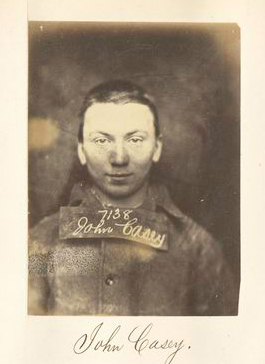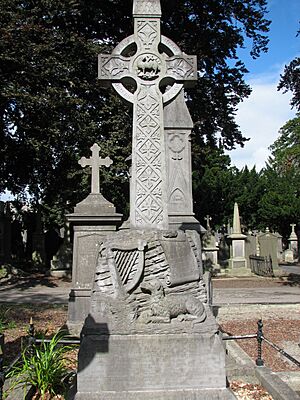John Keegan Casey facts for kids
John Keegan "Leo" Casey (born 1846, died 1870) was a famous Irish poet and speaker. People called him the Poet of the Fenians. He is best known for writing the song "The Rising of the Moon". John Casey was an important person in the Fenian Rising of 1867. He was put in prison and passed away on St. Patrick's Day in 1870.
Contents
John Casey's Early Life and Family
John Casey was born in 1846 in Mount Dalton, County Westmeath, Ireland. His father was a teacher. This was during a very difficult time in Ireland, known as the Great Hunger.
When John was eight years old, his family moved. They went to Gurteen, near Ballymahon in County Longford. His father became the head teacher at the local school there. John Casey's writings later became strongly connected with Ballymahon.
Becoming a Poet
As a teenager, John helped his father with teaching. Many expected him to become a teacher too. However, he felt that the school lessons were not patriotic enough. He spent a lot of his time writing poetry instead.
It was around this time, when he was about fifteen, that he wrote his most famous song. This song was "The Rising of the Moon". It remembers the Irish Rebellion of 1798, a big event in Irish history.
Joining the Fenians
John Casey's songs and poems became very popular. People sang them at meetings where Irish independence was discussed. In the 1860s, he moved to Dublin. There, he became very active in the Fenian movement.
The Fenians were a group of Irish people. They wanted Ireland to be free from British rule. John Casey wrote many articles for The Nation newspaper. He used the pen-name 'Leo' for his writings.
A Wreath of Shamrocks
In 1866, when he was 20, John Casey published a book of poems. It was called A Wreath of Shamrocks. Most of these poems had already been printed in The Nation newspaper.
The success of his book made him even more famous. People wanted him to speak at their events. He gave speeches at large gatherings in Dublin, Liverpool, and London. This was all happening before the Fenian Rising in 1867.
Time in Prison
The Fenian uprising in 1867 did not succeed. After it failed, John Casey was arrested. He was held in Mountjoy Prison for eight months. He was kept there without a trial.
John Casey was eventually released from prison. The authorities expected him to leave Ireland and go to Australia. However, he decided to stay in Summerhill, Dublin. He lived quietly, pretending to be a Quaker. He continued to write and publish his works in secret.
John Casey's Death
John Casey married Mary Josephine Briscoe in January 1868. They had a son named Michael, but sadly, he passed away shortly after birth in October 1869.
John's health had become very weak because of his time in prison. In 1870, he fell from a horse-drawn cab near O’Connell Bridge in Dublin. He died from his injuries.
He passed away on St. Patrick's Day in 1870. John Keegan Casey was buried in Glasnevin Cemetery. Newspapers reported that between fifty and one hundred thousand people walked in his funeral procession. This showed how much he was loved and respected.



